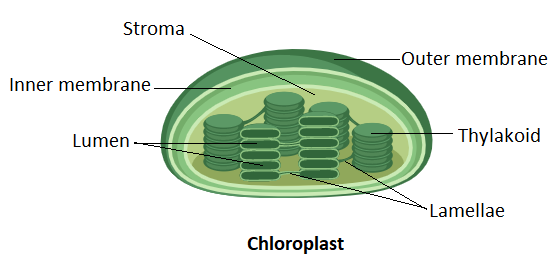
Dark reaction of photosynthesis occurs in
A. Thylakoid membrane
B. Membranes of stroma lamellae
C. Between two membranes of the chloroplast
D. Stroma of chloroplast outside lamellae
Answer
555k+ views
Hint:The dark reaction forms a significant phase of photosynthesis in plants where light is not needed. These are also called light-independent reactions or Calvin cycle. It occurs at the site of the chloroplast. Glucose is made in this reaction which is utilized by cells as chemical energy.
Complete answer:Photosynthesis is the process of making food in a plant where sunlight along with carbon dioxide and water is used to derive chemical energy. The dark reaction makes up a significant part of photosynthesis. This stage consists of the Calvin cycle. The Calvin cycle occurs at the site of the chloroplast. The chloroplast is the organelle in the plant cells that consists of chlorophyll that is a green pigment. Specifically, it occurs within the fluid that surrounds the thylakoid. This refers to the stroma of chloroplast which lies outside the lamellae and encircles the thylakoid sacs. The Calvin cycle results in the formation of glucose from the light energy absorbed in light-dependent reactions. The dark reaction does not need light directly but they harness the products of light energy processing. These products are ATP and NADPH.

Dark reaction is a biosynthetic phase where carbon reduction occurs and is converted into glucose. The dark reaction or the Calvin cycle occurs in three steps named carbon fixation, reduction reaction, and Ribulose 1,5-bisphosphate regeneration also called RuBP regeneration.
RuBP is a five-carbon molecule and is converted into two three-carbon molecules. These are called 3- phosphoglycerate (3PGA). The main catalyst of dark reactions is RUBISCO. After this, carbon reduction and RuBP regeneration occurs.
Hence, from the above discussion, we can conclude that the right answer is option D.
Note: The dark reaction forms the second phase of photosynthesis. It mediates in the synthesis of bio-organic compounds that are necessary for cell functioning and metabolism. A total of 6 ATP are used in one Calvin cycle that produces 1 glucose molecule.
Complete answer:Photosynthesis is the process of making food in a plant where sunlight along with carbon dioxide and water is used to derive chemical energy. The dark reaction makes up a significant part of photosynthesis. This stage consists of the Calvin cycle. The Calvin cycle occurs at the site of the chloroplast. The chloroplast is the organelle in the plant cells that consists of chlorophyll that is a green pigment. Specifically, it occurs within the fluid that surrounds the thylakoid. This refers to the stroma of chloroplast which lies outside the lamellae and encircles the thylakoid sacs. The Calvin cycle results in the formation of glucose from the light energy absorbed in light-dependent reactions. The dark reaction does not need light directly but they harness the products of light energy processing. These products are ATP and NADPH.

Dark reaction is a biosynthetic phase where carbon reduction occurs and is converted into glucose. The dark reaction or the Calvin cycle occurs in three steps named carbon fixation, reduction reaction, and Ribulose 1,5-bisphosphate regeneration also called RuBP regeneration.
RuBP is a five-carbon molecule and is converted into two three-carbon molecules. These are called 3- phosphoglycerate (3PGA). The main catalyst of dark reactions is RUBISCO. After this, carbon reduction and RuBP regeneration occurs.
Hence, from the above discussion, we can conclude that the right answer is option D.
Note: The dark reaction forms the second phase of photosynthesis. It mediates in the synthesis of bio-organic compounds that are necessary for cell functioning and metabolism. A total of 6 ATP are used in one Calvin cycle that produces 1 glucose molecule.
Recently Updated Pages
Why are manures considered better than fertilizers class 11 biology CBSE

Find the coordinates of the midpoint of the line segment class 11 maths CBSE

Distinguish between static friction limiting friction class 11 physics CBSE

The Chairman of the constituent Assembly was A Jawaharlal class 11 social science CBSE

The first National Commission on Labour NCL submitted class 11 social science CBSE

Number of all subshell of n + l 7 is A 4 B 5 C 6 D class 11 chemistry CBSE

Trending doubts
10 examples of friction in our daily life

One Metric ton is equal to kg A 10000 B 1000 C 100 class 11 physics CBSE

Difference Between Prokaryotic Cells and Eukaryotic Cells

1 Quintal is equal to a 110 kg b 10 kg c 100kg d 1000 class 11 physics CBSE

State the laws of reflection of light

Explain zero factorial class 11 maths CBSE




